Spice up your fall observing with a dash of Pallas and nibble of Neptune. Both planet and asteroid are easy to spot in a small telescope.
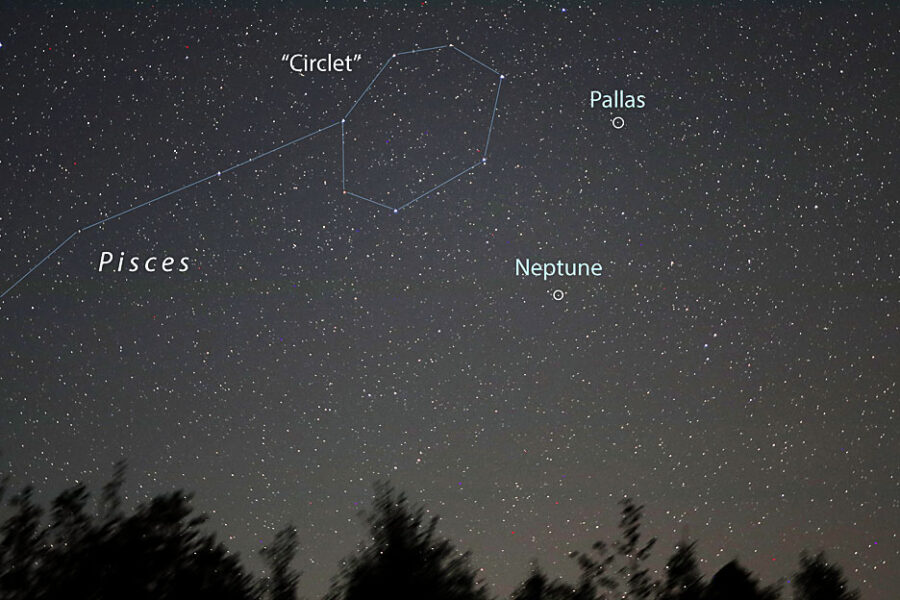
Bob King
I've never been able to wrap my mind around the fact that the total mass of the main asteroid belt equals just 4% the mass of the Moon. That seems hardly enough to matter, and yet our fate rests on those scraps and shards. A single smack from a 10-kilometer-wide stray and humanity — along with thousands of other species — could face the possibility of extinction. Their small bulk paired with their outsize destructive potential is just one reason to observe asteroids.
Certainly, they appear innocent enough. Even at high magnification in amateur telescopes minor planets look like inconsequential pinpoints of light. But unlike stars, they move against the stellar backdrop as they orbit the Sun. This makes them fun to track, like watching a favorite runner in the race. Irregularly shaped asteroids often show light variations that betray their rotation. Other have been linked to meteorites found on Earth, proving that siblings of these bodies continue to affect the planet in the most direct way imaginable — through routine impacts.
First acquaintance
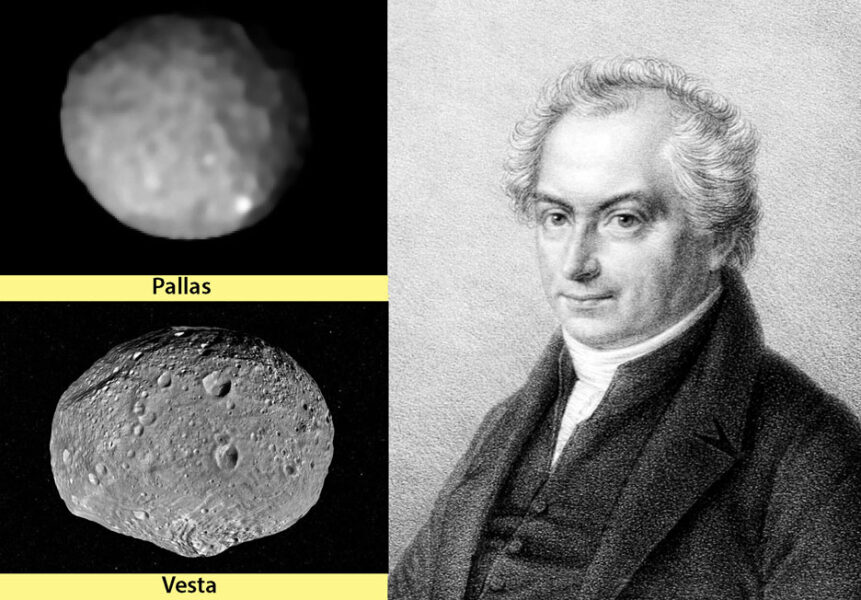
Top: ESO / Vernazza et al.; Bottom: NASA / JPL-Caltech
German astronomer Heinrich Olbers, the same person who made us pause and ponder the finitude of the universe with his famous Paradox, discovered Pallas while following Ceres (the first asteroid discovered) in Virgo on March 28, 1802. As he acquainted himself with additional stars in that constellation to more easily track Ceres' motion that evening, he noticed a "new" 7th-magnitude star close to 20 Virginis. After more than two hours of observation he suspected motion. Luckily, the following night was clear. Olbers confirmed its movement and claimed discovery of the second asteroid.
Like other early asteroids, Pallas was initially considered a planet. The rapidly increasing number of similar discoveries nudged astronomers into recategorizing them as minor planets or asteroids. Pallas is the third largest with dimensions of 582 × 556 × 500 kilometers and an ellipsoidal shape.
After the discovery of 3 Juno in 1804 (by fellow German astronomer Karl Ludwig Harding), Olbers hypothesized all three were fragments of a defunct planet that had undergone catastrophic destruction. There must be more pieces. So he searched the sky where the orbits of the trio approached one another and in 1805 discovered the fourth asteroid Vesta. Although we now know no planet inhabited the asteroid belt thanks to the waving of Jupiter's gravitational wand, Olbers's hunch inspired his Vesta find.
Hop aboard
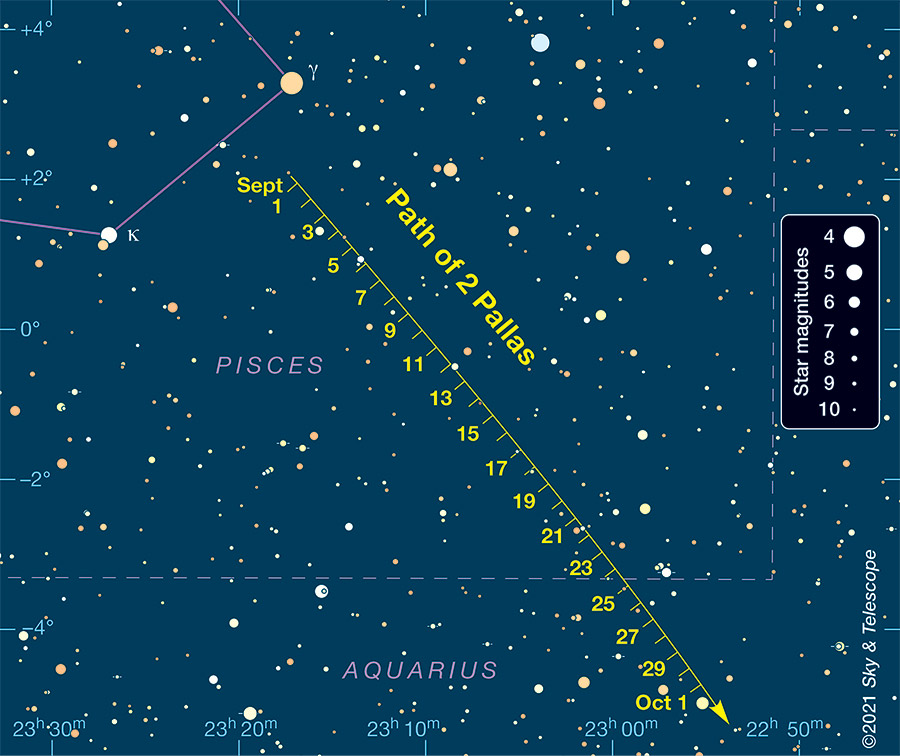
Sky & Telescope
Pallas came to opposition on September 10th and remains bright enough to see in 50-mm binoculars all month from a moderately dark sky. Currently at magnitude 8.6, it fades to 8.9 by month's end while crossing from western Pisces into eastern Aquarius.
Closest approach to Earth of 320.4 million kilometers occurs on September 15th, but this opposition isn't a particularly close one. At best Pallas can shine as brightly as magnitude 6.6 and be seen without optical aid from a very dark sky. That next happens in March 2028. Still, anytime an asteroid is bright enough to see in binoculars and small telescopes it adds welcome spice to the evening lineup.
Money, money, money
The precious element palladium (discovered in 1803 by English chemist William Wollaston) is named after Pallas, which in turn is named for Athena, the ancient Greek goddess of wisdom. The chief use of the precious metal is in catalytic converters for cars. Each contains a few grams apiece of palladium, rhodium, and platinum, all worth good money and the reason they're targeted by thieves.
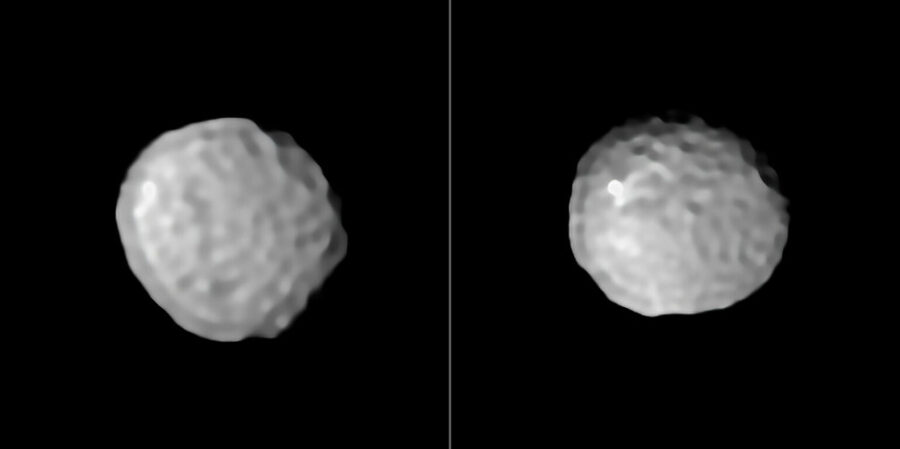
ESO / Vernazza et al.
Reflectance spectroscopy indicates that Pallas is a B-type asteroid related to CK and CM carbonaceous chondrite meteorites. These materials provided crucial carbon-rich compounds, water, and amino acids to the early Earth that may have played a role in the evolution of life. Carbon-rich rocks also tend to be dark-colored, which probably accounts for Pallas's low albedo of about 0.12, making it as gloomily reflective as our own Moon.
We'll soon have the first in-situ samples of the B-type asteroid 101955 Bennu in hand when NASA's OSIRIS-REx spacecraft dispatches a sample cannister to Earth during its September 2023 flyby. Perhaps these blackened bits will also illuminate our understanding of Pallas.
Despite Pallas's "boring" appearance in a telescope it's important to keep such facts in mind because they deepen our appreciation of the little we see directly. Let me share a couple more. While many asteroids cycle around the sky near the ecliptic, Pallas's steep inclination of 34.8° means it strays far to the ecliptic's north and south. Additionally, Pallas has a very high axial tilt of approximately 84°. Large parts of its surface experience continuous sunlight or darkness for a period up to a year and double that for areas near the poles.
I hope you two get acquainted this month.
Nibble of Neptune
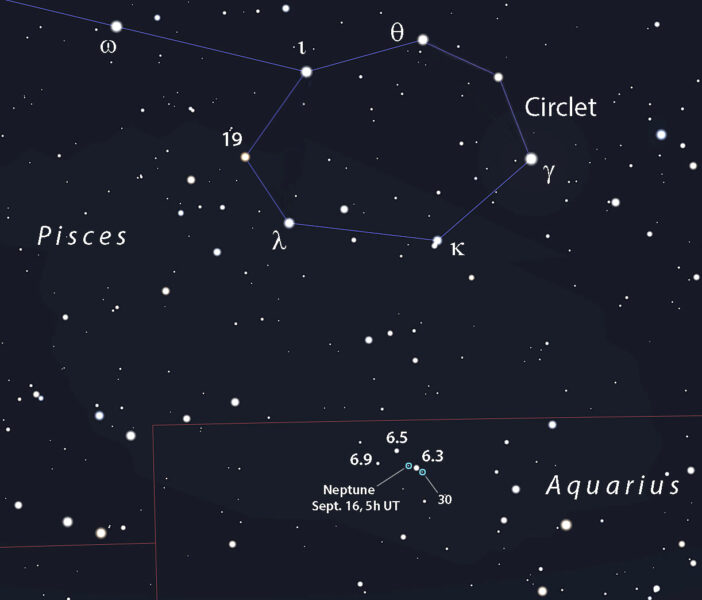
Stellarium
Coincidentally, the planet Neptune also reached opposition this month on September 14th in eastern Aquarius not far from Pallas. Slightly brighter at magnitude 7.8, it's relatively easy to spot in a pair of 10×50 binoculars. On the night of September 23–24 the methane-blue planet passes just 1.6′ south of 6.3-magnitude HD 221148. Modest-aperture telescopes will show it as a tiny, aqua disk at a magnification of 100× or higher.
If you have a 10-inch or larger instrument be sure to look for its brightest and largest moon, Triton, which never strays far from the mothership. This season its distance ranges from 9.5″ to 17″. Use 200× or higher to separate the 13.5-magnitude speck from Neptune's glare when it's at or near greatest elongation. To pinpoint its position anytime, check out Sky & Telescope's Triton Tracker.
 7
7









Comments
Zubenelgenubi 61
September 15, 2021 at 5:31 pm
Fun Fact: The evening of September 23-24 will mark the 175th anniversary of the discovery of Neptune.
You must be logged in to post a comment.
Bob KingPost Author
September 16, 2021 at 12:33 am
Thank you, Zubenelgenubi, for that interesting tidbit!
You must be logged in to post a comment.
Anthony Barreiro
September 15, 2021 at 5:37 pm
I've been following Neptune through 10x 42 image-stabilized binoculars for the past couple of months, when the weather has cooperated. The circlet of Pisces is not visible to the unaided eye through urban light pollution, so I start my star hop at magnitude 2.4 Enif, Epsilon Pegasi -- southeast to Theta Pegasi, south-southeast to the water jar of Aquarius, due south to Theta Aquarii, a long hop east to orange Lambda Aquarii, east-northeast to Phi Aquarii. The distinctive wide triple of Psi Aquarii is about four degrees south of Phi and confirms that I'm in the right place. In the chart above, Phi is the brightest star to the west of Neptune. I see the two sixth-magnitude stars less than two degrees east-northeast of Phi as a gate I pass through on the way to Neptune. Neptune is usually right on the edge of visibility with the 10x42's through the light pollution, a little sharper when the sky is very clear.
I've looked for Pallas a few times, but no luck. That darned logarithmic magnitude scale. Neptune is twice as bright as Pallas! I should bring out the 15x70 binoculars, or the 102 mm refractor, but I'm lazy.
You must be logged in to post a comment.
Bob KingPost Author
September 16, 2021 at 12:35 am
Anthony,
Damned logarithmic indeed! Thanks for the chuckle and for your preferred route to Neptune. I'm confident you'll see Pallas soon 🙂
You must be logged in to post a comment.
ddrs
December 12, 2023 at 2:09 pm
12-12-23
Hi, Bob -- I finally got around to playing with the photos I attempted of Pallas back in Aug and Sept 2021. I used my Nikon D7100 and a Nikkor 18-140 on a tripod, ISO 1600, and about 5-6 seconds exposure. Out of the innumerable stars, I thought I had picked out Pallas on 4 different nights, but i didn't feel like I had papal infallibility. Then I found your picture, added your Sep 12 Pallas to my Pallases and drew a line between them and got a straight line. That was cool, but then I took the S&T star map and found its line coincided with mine (although it doesn't go back to August). But trying to match the dates of my photos -- and yours -- with the S&T line doesn't work. I think its dates are off by 1 day to the left (e.g., Sep 5 is really Sep 4). What do you think? How do I send you my pics? Dave Sussman
You must be logged in to post a comment.
Bob KingPost Author
December 12, 2023 at 3:04 pm
Hi Dave,
Thanks for writing. Is it possible the dates are off by one because of UT? S&T maps use 0h UT as the date.
Bob
You must be logged in to post a comment.
ddrs
December 12, 2023 at 11:38 pm
Of course. 10 or 11 PM mountain daylight time makes Sep 4 Sep 5 in England. Never occurred to me. Thanks.
Dave
You must be logged in to post a comment.
You must be logged in to post a comment.